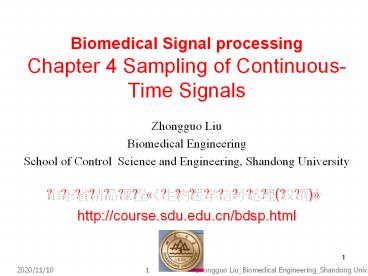Biomedical Signal processing Chapter 4 Sampling of Continuous-Time Signals - PowerPoint PPT Presentation
Title:
Biomedical Signal processing Chapter 4 Sampling of Continuous-Time Signals
Description:
Biomedical Signal processing Chapter 4 Sampling of Continuous-Time Signals Zhongguo Liu Biomedical Engineering School of Control Science and Engineering, Shandong ... – PowerPoint PPT presentation
Number of Views:496
Avg rating:3.0/5.0
Title: Biomedical Signal processing Chapter 4 Sampling of Continuous-Time Signals
1
Biomedical Signal processingChapter 4 Sampling
of Continuous-Time Signals
- Zhongguo Liu
- Biomedical Engineering
- School of Control Science and Engineering,
Shandong University
???????????????(??) http//course.sdu.edu.cn/bds
p.html
2020/11/10
1
Zhongguo Liu_Biomedical Engineering_Shandong Univ.
2
Chapter 4 Sampling of Continuous-Time Signals
- 4.0 Introduction
- 4.1 Periodic Sampling
- 4.2 Frequency-Domain Representation of Sampling
- 4.3 Reconstruction of a Bandlimited Signal from
its Samples - 4.4 Discrete-Time Processing of Continuous-Time
signals
3
4.0 Introduction
- Continuous-time signal processing can be
implemented through a process of sampling,
discrete-time processing, and the subsequent
reconstruction of a continuous-time signal.
4
4.1 Periodic Sampling
Unit impulse train
- Continuous-time signal
impulse train sampling
T sampling period
Sampling sequence
5
?????????
Tsample period fs1/Tsample rateOs2p/Tsample
rate
s(t)??????,???T,????????
6
4.2 Frequency-Domain Representation of Sampling
Tsample period fs1/Tsample rate Os2p/T
sample rate
7
DTFT
8
DTFT
Continuous FT
9
Nyquist Sampling Theorem
- Let be a bandlimited signal with
- . Then
is - uniquely determined by its samples
-
, if - The frequency is commonly referred as
the Nyquist frequency. - The frequency is called the Nyquist
rate.
10
frequency spectrum of ideal sample signal
No aliasing
aliasing
11
Example 4.1 Sampling and Reconstruction of a
sinusoidal signal
Compare the continuous-time and discrete-time FTs
for sampled signal
Solution
12
Example 4.1 Sampling and Reconstruction of a
sinusoidal signal
continuous-time FT of
discrete-time FT of
13
???(?????)??????????
14
Example 4.2 Aliasing in the Reconstruction of an
Undersampled sinusoidal signal
Compare the continuous-time and discrete-time FTs
for sampled signal
Solution
15
4.3 Reconstruction of a Bandlimited Signal from
its Samples
Gain T
16
4.4 Discrete-Time Processing of Continuous-Time
signals
17
C/D Converter
- Output of C/D Converter
18
D/C Converter
- Output of D/C Converter
19
4.4.1 Linear Time-Invariant Discrete-Time Systems
Is the system Linear Time-Invariant ?
20
Linear and Time-Invariant
- Linear and time-invariant behavior of the system
of Fig.4.11 depends on two factors - First, the discrete-time system must be linear
and time invariant. - Second, the input signal must be bandlimited, and
the sampling rate must be high enough to satisfy
Nyquist Sampling Theorem.(??????)
21
effective frequency response of the overall LTI
continuous-time system
22
4.4.2 Impulse Invariance
Given
Design
impulse-invariant version of the continuous-time
system
23
4.4.2 Impulse Invariance
- Two constraints
????
The discrete-time system is called an
impulse-invariant version of the continuous-time
system
24
4.5 Continuous-time Processing of Discrete-Time
Signal
25
4.5 Continuous-time Processing of Discrete-Time
Signal
26
4.5 Continuous-time Processing of Discrete-Time
Signal
Figure 4.18 Illustration of moving-average
filtering. (a) Input signal xn cos(0.25pn).
(b) Corresponding output of six-point
moving-average filter.
Errata
27
Review
- What is Nyquist rate?
- What is Nyquist frequency?
- The Nyquist rate is two times the bandwidth of a
bandlimited signal. - The Nyquist frequency is half the sampling
frequency of a discrete signal processing
system.( The Nyquist frequency is one-half the
Nyquist rate)
28
- What is the physical meaning for the equation
DTFT of a discrete-time signal is equal to the FT
of a impulse train sampling .
Review
- DTFT derived from the equation.
- impulse train sampling xs(t) and xn have the
same frequency component.
29
How many factors does the linear and
time-invariant behavior of the system of Fig.4.11
depends on ?
Review
- First, the discrete-time system must be linear
and time invariant. - Second, the input signal must be bandlimited, and
the sampling rate must be high enough to satisfy
Nyquist Sampling Theorem.(??????)
30
Assume that we are given a desired
continuous-time system that we wish to implement
in the form of the following figure, how to
decide hn and H(ejw)?
Review
31
Chapter 4 HW
- 4.5
???
???
? ?

